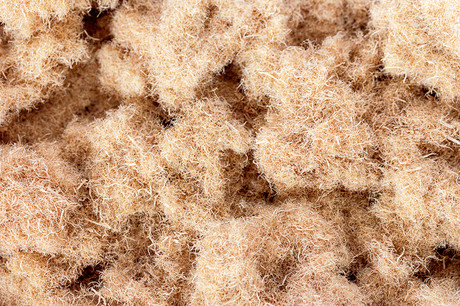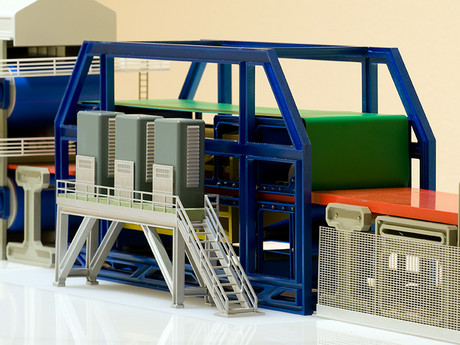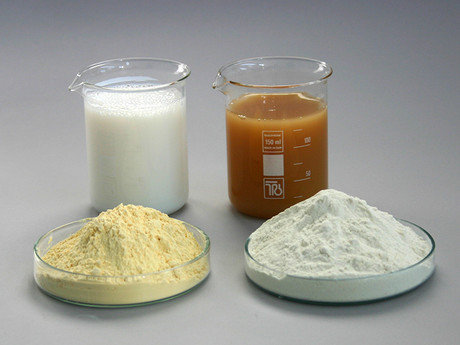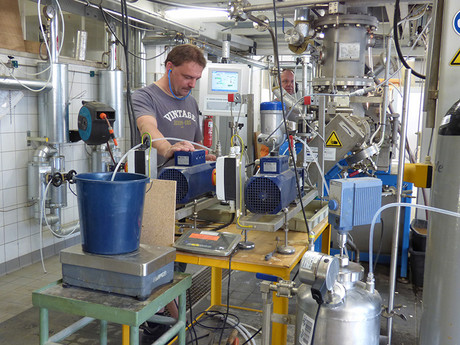Materials
The material use of the resource ‘wood’ is at the focus of the ‘Materials’ area. Wood-based materials are investigated, developed and manufactured with the latest laboratory and technical equipment.
The main activities of the ‘Materials’ department are centred on the laboratory manufacture and analysis of wood particles (particles, strands, fibres) and of any kind of wood-based materials (panels, mouldings, special products).
With state-of-the-art technical facility, the entire value creation chain from round wood to finished panels can be reproduced.
The range of services is completed by special tests such as determining the density profile, creep behaviour and dimensional stability.
- Particle manufacture and analysis
- Manufacture of wood-based materials
- Development and optimisation of wood-based materials
- Testing of glues and additives
- Technology optimisation and consultancy
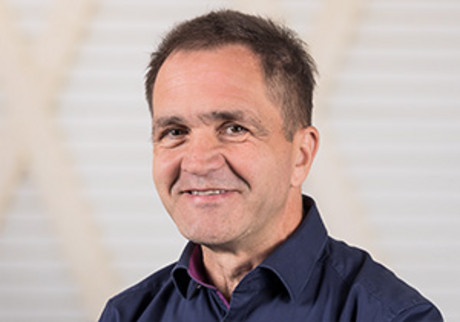
Prof. Dr. rer. nat.
Detlef Krug
Head of Departement · MDF · OSB · PB · SWP · Adhesives · Alternate feedstocks · Monitoring
Particle Manufacture and Analysis
The conversion of solid wood into wood particles is at the central focus of ‘Wood based Material Production’. Only by preparing special lignocellulose structural elements (from flour to strands) wood based materials intended for use in defined applications can be manufactured.
The manufacture of wood particles of various sizes and qualities is possible:
The ´Material´ area is equipped with numerous laboratory devices for the disintegration of raw timber, recycled products, annual plants and other agricultural products:
- Drum chipper (different dimension)
- Knife ring chipper, disk chipper, long-log flaker
- Hammer mill, cross beater mill and turbo mill with cooling unit
- Laboratory defibration unit (12“-Refiner) with material pre-treatment (pre-heating, MSD) and blowline and flash tube dryer
- Hydrothermal disintegration of lignocelluloses
- Atmospheric refiner
- Fibre classifier
The impact of the geometry and composition of particles or particle blends onto the manufacturing process and the properties of the product can be evaluated by applying special analytical methods. By identifying these correlations, the technology of chipping and defibration processes can be optimised and further developed continuously.
- Dynamic picture analysis by Camsizer (particle and fibre geometry)
- Air jet sieve (fibres)
- Vibratory sieve shaker (particles, strands)
- Bulk density
- Force-Tensiometer for the analysis of the wettability of particles and fibres
- Confocal laser scanning microscopy (CLSM) with time-resolved fluorescence spectroscopy for the investigation of the distribution of adhesives and additives on wood particles
- Digital microscope
- Micro tension device for single fibre measurement
- Dielectric loss measurement apparatus
Manufacture of wood-based materials
Shaping and moulding enables the manufacture of widely varying wood-based materials for use in load-bearing and non-load-bearing applications. On the one hand, laminated wood products, such as solid wood panels and plywood, that are very similar to solid wood and on the other hand particle-based materials (made of chips or fibres), are manufactured in the ‘Materials’ department.
The technical equipment permits industrial-scale transition of the various processes of the manufacture of the organically and inorganically bonded wood-based materials, from the application of the adhesive before and after drying to pressing the final material. Several technical solutions are available for transforming layers or particles:
Adhesive application:
- Different blenders for particles (1), (2), (3)
- Blowline for the continuously application on fibres (different nozzles)
- Manual application machines for laminar bonding
Mat forming:
- Moulding boxes for manual mat forming
- Particle spreading machine and fibre mat forming station for automatic mat forming
Presses
- Hot presses with re-cooling and castings (1), (2), (3), for different moulds
- High-frequency heating press
- Solid-wood panel press
- Short-cycle press
Manufacture of insulation material
As to what extent materials are fit for certain applications or meet the desired requirements are investigated on laboratory and industrial panels with the help of various short-term or long-term tests. The analyses includes the testing of biological, physical and mechanical and surface properties and of the emission behaviour of wood-based materials in the relevant department at IHD. The ‘Materials’ department can carry out the following tests:
Development and optimisation of wood-based materials
The optimisation and further development of wood-analogue materials is a central topic of work in the ‘Materials’ department.
Along with the ever recurring themes of sustainability, conservation of resources, climatic change and energy consumption, legal restrictions and consumer acceptance (e.g. VOC and formaldehyde) the following issues are among those of current topicality:
- Variation of raw material application (e.g., alternative wood species, annual plants)
- Continuous disintegration of lignocellulose raw materials (chip and fibre manufacture)
- Application of traditional organic and inorganic bonding agents as well as of alternative bonding agents/bonding agent combinations (e.g., proteins, cement)
- Composite panels with alternative and functional core layers
- Thermally or chemically modified wood-based materials
- Insulation materials from organic raw materials
- Paper and cardboard in dry process for packaging purposes (flat cardboard, corrugated cardboard)
- Production of MDF and packaging materials from dry pulp waste paper
- Functionalisation (powder coatability, mouldability, heating/cooling, flame retardancy)
- Configuration of the density profile
- Development of test methods (e.g. short-term creep behaviour)
Testing of glues and additives
The development of wood-based materials is closely linked to the development of suitable adhesive systems. Without any bonding agents, most lignocellulose-based materials hardly be produced. High speed of reaction, low emissions, low cost, sufficient availability and good cross-linking capability with the structural elements, for example, are of decisive importance to a successful adhesive.
On the one hand, the ‘Materials’ department tests the technological implementation of the gluing of particles (blender, blowline) or of layers (roller and spatula application) with various adhesives and additives as well as their impact on the pressing process (pressing time, pressure, temperature). On the other hand, it determines the parameters of the acquired bonding quality (e.g., gel time, resin dispersion or internal bond). Apart from the classical adhesives based on formaldehyde or isocyanates, alternative bonding systems are the subject of investigations, such as thermoplastics (PVAc, EPI), natural polymers (proteins, lignin), inorganic bonding agents (cement, gypsum, soluble glass) as well as wood-inherent bonding forces. In addition to that, several additives are applied to purposefully improve the materials (e.g., regarding hydrophobing, fire protection, emissions reduction).
Technology optimisation and consultancy
Next to the ecological aspects, the marketing potential of a material largely depends on its price. For this reason, technology optimisations in the manufacture of wood-based materials focusses in particular the saving of energy and material. The technology optimisation of wood-based materials comprises a series of procedural steps, from the manufacture of particles to hot pressing.
The ‘Materials’ department deals with the following topics in particular for developing existing technologies further:
- Generation of well-defined chip and strand geometries by varying the cutting edge geometry and angles in various chipping units
- Determination of optimal pulping conditions in the refiner (retention time, pressure, temperature, disc gap, fibre discharge) to achieve the desired fibre sizes and qualities
- Effects of different raw materials on the energy consumption during the disintegration process
- Reducing the adhesive content by improving the application of adhesive to fibres in the blowline and by using combination or dry gluing technology
- Investigation of the impact of the particle geometry onto the compression process
Services
- Continuous manufacture of defined wood particles (e.g. chips, strands, particles and fibres)
- Hydrothermal disintegration of lignocelluloses
- Defined disintegration of different raw materials with a horizontal turbo mill with the possibility of active cooling
- Continuous classification of fibres
- Morphological analysis of particles by screening (vibrating sieve for chips, strands and particles, air jet sieve fibres and fines) and digital image analysis (Camsizer) of particles and fibres
- Determination of the bulk density
- Analysis of the wettability of particles and different test fluids with a Force-Tensiometer (contact angel, surface and interfacial tension)
- Industrial analogue fibre production and adhesive application (blowline)
- Air stream fibre mat forming for the manufacture of thin uniform mats
- Manufacture of wood-based composites applying various adhesives and additives
- Optimisation of production technology for e.g. combination gluing, raw material use, fibre pulping grade, chip and strand geometry, press conditions
- Automatic particle mat forming station for single- and multilayer mats
- Evaluation of duration of load and creep behaviour of wood based materials
- Evaluation of dimensional stability of wood based materials in different climatic conditions
- Determination of density profile
- Outdoor weathering
- Micro tension device for single fibre measurement
- Determination of dielectric loss of particles, fluids and solids
Technical equipment
Log processing:
- Rotor debarker
- Wood splitter
- Drum chipper
- Vibrating sieve
Chipping:
- Knife ring flaker
- Long log flaker
- Cross beater mill (knife ring mountable)
- Hammer mill
- Drum dryer for strands
- Flash tube dryer for chips
- Tumbler screening sieve
- Turbo mill
Pulping:
- Laboratory defibration unit (12“-Refiner) with material pre-treatment (pre-heating, MSD)
- Blowline gluing
- Flash tube dryer
- Atmospheric defibrator
Hydrothermal disintegration of lignocellulose:
- Boiler (Retention vessel)
- Discharge by steam explosion and at atmospheric conditions
Blending:
- Various blenders for fibre-like materials
- Various blenders for chip-like materials
- Blender for strands
Mat forming:
- Automatic particle mat forming station
- Automatic fibre mat forming station
Pre-pressing:
- HF-pre-press (high frequency preheating)
Pressing:
- Downstroke presses (cooling system, moulding possible)
- Upstroke high-speed-press
- Upstroke press for layer based composites
- HF-press (high frequency press)
Insulation materials manufacturing:
- Steam flow wood insulation press
- HF-press (high frequency press)
Particle analyses:
- By dynamic image analyses (Camsizer)
- By screening (air jet sieve, vibrating screening machine)
- Bulk density
Special testing’s:
- Density profile analysis
- Creep properties/duration of load acc. to EN 1156
- Dimensional stability acc. to IHD standard in differential air
- Outdoor weathering
- Automated bonding evaluation system (ABES)
- Force-Tensiometer for the determination of the particle wettability
- Confocal laser scanning microscopy (CLSM) with time-resolved fluorescence spectroscopy for the investigation of the distribution of adhesives and additives on wood particles
- Digital microscope
- Micro tension device for single fibre measurement
- Dielectric loss measurement apparatus

